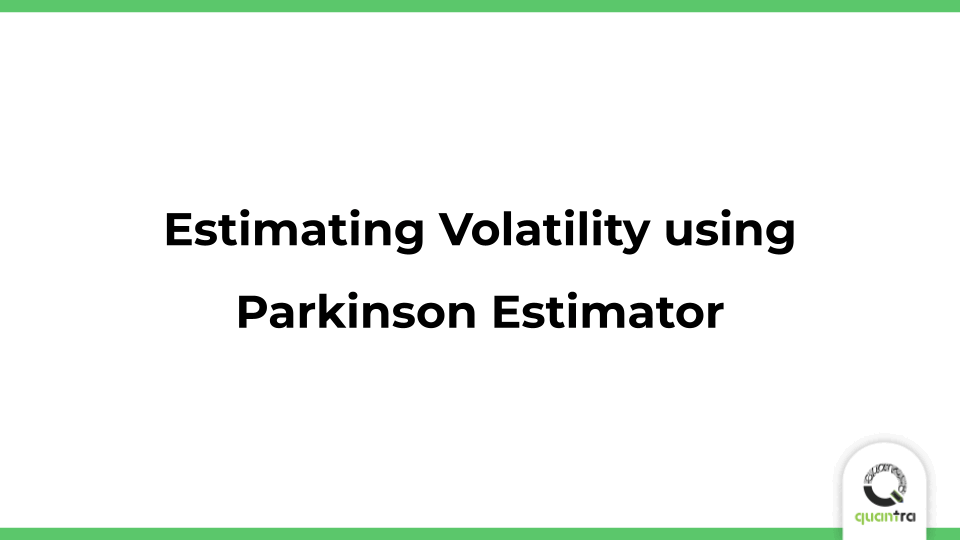Estimating Volatility using Parkinson Estimator
In this post. we will discuss in detail the need for volatility estimation and how to estimate volatility using the Parkinson estimator.
What is Volatility?
Volatility in financial assets is all about how much and how quickly the price of an asset changes. Let's look at two well-known companies: Coinbase (COIN) and Coca-Cola (KO).
Coinbase has high volatility. Its stock price can go up or down by a large percentage in a short period of time. This means that Coinbase’s stock is more unpredictable and can have big price swings.
On the other hand, Coca-Cola has low volatility. Its stock price tends to have smaller and more consistent changes over time. This means that Coca-Cola's stock is more stable and doesn't experience as much rapid fluctuation.
When traders talk about volatility, they are concerned with the level of risk and uncertainty associated with a stock's price movements.
All the concepts covered in this post are taken from the Quantra course on Options Volatility Trading: Concepts and Strategies. You can preview the concepts taught in this course by clicking on the free preview button.
Note: The links in this tutorial will be accessible only after logging into quantra.quantinsti.com and enrolling for the free preview of the course.
Why should a trader be interested in estimating volatility?
Well, it actually gives them some pretty useful information! Estimating volatility helps traders in several ways, including managing risk, selecting which trades to make, determining the optimal time to enter or exit a trade, pricing options, developing strategies, and evaluating returns while considering the associated level of risk. Essentially, it's a vital tool that enables traders to make informed decisions and navigate the ever-changing nature of financial markets.
How to estimate volatility?
Volatility estimators are statistical tools used to estimate the volatility of a financial asset or market. They attempt to quantify the magnitude of price movements or returns by providing a numerical measure of volatility. The most common types of volatility estimators are:
- Close-to-close
- Parkinson
- Garman-Klass
- Rogers-Satchel
- Yang-Zhang
The close-to-close estimator of volatility is a simple estimator which uses the close prices of an asset to estimate the volatility. The Parkinson estimator is considered an effective volatility estimator as it uses twice the number of data points as the close-to-close estimator values. Let us dive deeper into the concept of volatility estimation using the Parkinson estimator.
Parkinson Estimator: Calculation
The Parkinson estimator uses the daily high and low prices to estimate the volatility. The formula for the Parkinson volatility estimator is shown below:

where, N = No. of time periods
hi = high price
li = low price
The rationale behind the Parkinson estimator is that the larger the price range (high to low), the higher the volatility.
The Python code for estimating the volatility using the Parkinson estimator is covered in this unit of the Options Volatility Trading: Concepts and Strategies course. You need to take free preview and go to Section 13 and Unit 7 of the course.

Daily volatility of SPY using Parkinson estimator
You can see the daily volatility values ranges from 0.5% to 3.5%. The sharp spike seen in March 2020 is due to COVID-19 Pandemic declaration.
Parkinson Estimator: Advantage
The advantage of the Parkinson estimator is that it focuses on extreme price values, which are more likely to represent substantial price movements associated with volatility.

Parkinson Estimator focuses on high and low price values
Parkinson Estimator: Limitation
The Parkinson estimator assumes that night-time and daytime have the same true unobservable volatility. Generally, this isn’t true. In the graph shown below, we are comparing the SPY volatility in the day (measured from open to close) and night (measured from close to open).

SPY volatility in day and night
As you can see in the above graph, the volatility is more prevalent during the day than at night.
So does this mean that the Parkinson estimator is not well suited for volatility estimation?
Obviously not. Every estimator has its own pros and cons. We can’t say which one is the most accurate because we need to estimate the actual volatility using one of these estimators. If we knew the true volatility, we wouldn’t have to estimate it!
How can I use the estimated volatility in my trading?
The estimated volatility can be used as input to the volatility forecasting models like GARCH to forecast the volatility and take trades based on the forecasted volatility. For example, if an increase in volatility is anticipated, one can implement a long straddle strategy, whereas a short straddle strategy can be employed when a decrease in volatility is predicted.

The concept of forecasting volatility using the GARCH model and trading based on this forecasted volatility has been covered in detail along with the Python code in the Options Volatility Trading: Concepts and Strategies course.
What to do next?
- Go to this course
- Click on 'Free Preview'
- Go through 10-15% of course content
- Drop us your comments, queries on community
About the Course Author

The course 'Options Volatility Trading: Concepts and Strategies' was co-authored by Dr. Euan Sinclair, who possesses over 27 years of experience in the industry and has authored three books on options:'Options Trading', 'Volatility Trading', and 'Positional Options Trading'.
IMPORTANT DISCLAIMER: This post is for educational purposes only and is not a solicitation or recommendation to buy or sell any securities. Investing in financial markets involves risks and you should seek the advice of a licensed financial advisor before making any investment decisions. Your investment decisions are solely your responsibility. The information provided is based on publicly available data and our own analysis, and we do not guarantee its accuracy or completeness. By no means is this communication sent as the licensed equity analysts or financial advisors and it should not be construed as professional advice or a recommendation to buy or sell any securities or any other kind of asset.








